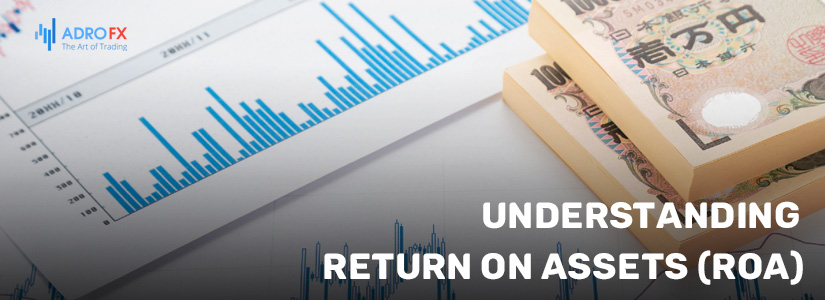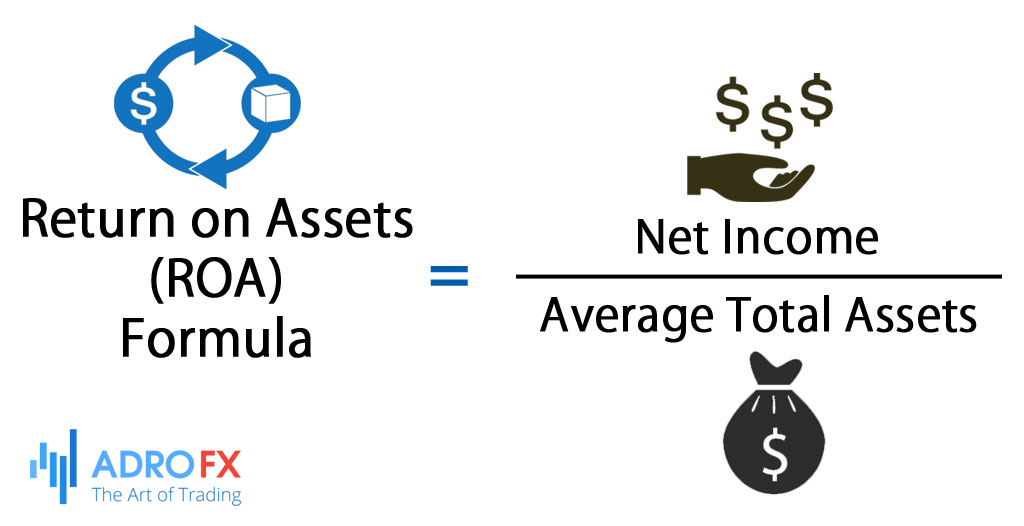Understanding Return On Assets (ROA)

Any adequate company works to generate profit . But it is an absolute indicator and shows how much funds the company has after the sale of products and payment of all expenses. For some people one million dollars is a lot, for others, it is not enough. However, earnings does not allow comparing different in scale companies - that is what profitability is for. In this article, we will tell you what it is, how to calculate it correctly and use it to enhance your investment portfolio.
What is the Return on Assets?
Every commercial organization has certain assets on its balance sheet, capable of generating revenue for the legal entity. If the company manages the assets rationally, its total annual income grows, and the ROA indicator has a high mark. If the ratio is low, it can be argued that there are systemic errors in capital management.
The return on assets ratio is a reflection of the rate of turnover of the company's total capital. It demonstrates how many times during a certain period there is a production cycle and circulation, which brings return. In other words, the indicator displays the amount of funds ney that each unit of its assets brings to the company's budget.
A simple formula can be used to calculate the number of assets turns over a fixed period. It allows you to understand how effective the measures taken in the process of generating earnings during business operations are. ROA is most often used by financial analysts in their calculations, to diagnose the performance of a particular firm. The resulting numerical value clearly demonstrates what return a company has on the use of all its assets. In other words: ROA shows how much profit is made per each unit of capital invested in an organization's property capital.
Using a whole system of ratios is a well-established practice that allows you to analyze the position of the firm. To get the full picture, of course, analysts need to have as much data as possible (the original balance sheet, income statement, etc.). But do not assume that a series of formulas is a reliable "predictor" that is guaranteed to bring success. Warren Buffett argues that a manager must have flair, which together with mathematical analysis, market monitoring, and an active position yields terrific results.
How to Calculate the ROA Ratio
When calculating the ROA ratio, economists and analysts use two basic concepts:
- The amount of a company's revenue taken over a single period;
- The total amount of working capital or the average annual value of all assets of an enterprise.
The formula is the ratio of net sales revenue to the average annual value of the firm's assets.  Usually, the figure is expressed as a percentage. For example, if the net profit of the retail shop is 4 million dollars, and the total value of the company's assets is 8 million, then calculate the ROA ratio as follows: 2/8 * 100=25%
Usually, the figure is expressed as a percentage. For example, if the net profit of the retail shop is 4 million dollars, and the total value of the company's assets is 8 million, then calculate the ROA ratio as follows: 2/8 * 100=25%
Here we should also define the key concepts:
- Assets are all tangible assets belonging to the company, which include not only capital but also debts.
- Assets of the company are funds and real estate, which together form its capital.
- The net profit of the company is the income received after the deduction of all expenses.
The Usefulness of the ROA Ratio
This rudimentary formula allows you to see how much profit a company makes on investments, and to understand if the property is fully engaged, by how much it adds to capital. It's valuable information that allows you to reexamine your business priorities, set a new direction for your business, optimize your costs, and find new markets. ROA often motivates managers to reorganize their businesses, stimulating them to make adjustments in the work of economists and financiers. In addition, the ratio can suggest what improvements can affect the value of gross revenue through more competent asset management.
Analysts often use the ROE ratio in their calculations, and unlike ROE, return on assets takes into account not just equity, but also all of a company's borrowed funds. Here, experts recommend analyzing historical data, that is, taking ROE data for past years into account. In this way, you can trace the dynamics of changes, and identify the peak of profitability and the reasons for the decrease in income from capital. The calculation is of enormous value not only to investors but also to executives of organizations and suppliers of goods. It is the value of the company and the quality of its work that helps to predetermine the amount of possible profit, which is what famous financiers have been saying for decades. The ability to analyze and objectively assess the situation is the key to success in business.
The decline in indicators does not always indicate an imminent crisis, because the main enemy is not the lack of capital, but the lack of desire to change the situation, to look at it from a different angle. Even the most successful business experiences a stage of stagnation, at this point, enlisting the help of a ROA indicator, the manager and their team of financiers can completely change the situation.
How to Understand ROA Readings
A decrease in ROA is most often associated with an increase in the company's liabilities to investors or a drop in net profit growth. If timely resort to the above formula, it is possible to stabilize the situation, to adjust the work with assets. The concept of the rate of return on assets is relative because it directly depends on the type of activity of the enterprise.
For example, in such industries as engineering, electrical power, coal mining, and other capital-intensive industries, the ROA ratio will certainly be lower than that of a company that sells goods and provides services. To the ROA figure much attention is paid by potential investors, who are willing to invest in companies that show positive dynamics.
It is noteworthy that different countries have their rate of ROA. For U.S. companies the average is 15%, while in Japan the norm is 7%. In Europe, the average ROA for large companies ranges from 10 to 15%. For the banking sector, even 1% is considered the norm.
You can also use ROS and ROIC to calculate the real quality of a company. ROS is a measure of the profitability of the enterprise. It is a simple ratio of net profit to the total sales of a company. The ROS helps investors understand what percentage of profit comes out of each dollar of revenue.
The ROIC ratio shows the return on that portion of capital that is invested. It shows how well a company handles its investment. The indicator is not relevant for the service sector and the industry where luxury goods are sold.
Advantages and Disadvantages of ROA
ROA can optimize a company's performance, identify weaknesses in the asset management process and encourage management to create a new concept of profit extraction. Analysts note that the ROA indicator has some inaccuracies as well. So what are the pros and cons of the ROA ratio formula? Pros:
- Demonstrates the performance of the company;
- Has a simple formula for calculation;
- Uses not only equity but also borrowed funds in the calculation, which makes the figure more accurate;
- Allows you to quickly eliminate redundancy.
Cons:
- Comparing the performance of the two companies, you need to pay attention to the structure of assets;
- Net income often has uncertainties;
- A high ratio sometimes "doesn't work" because the company has minimal capital or a negative balance sheet.
While the ROA ratio in some cases should not be perceived as the main tool to determine the liquidity of the assets of the organization, it clearly demonstrates the general situation. In combination with other calculations and indicators, it can reveal the true state of affairs in the company. A comprehensive assessment of a company's performance is the key to a successful investment. The iconic investor Warren Buffett, in his writings, has repeatedly pointed to the fact that one should be wary of "formula nerds". You can ignore a company's historical development and spend the lion's share of your time studying sales charts, but the concept of "return on assets" can open your eyes to a company's performance. In this case, Buffett, as always, demonstrated competence, as the application of formula alone is capable of demonstrating the level of quality of capital management of a huge firm.
Applying ROA Ratio to Investment
When analyzing profitability, the investor must comply with several rules to get an objective picture of the company's activities. Do not look for normative values. Profitability indicators do not have normative values. The investor should compare them with the company's past data, with the industry average, and with the data of competing companies. Analyze the dynamics. The investor should evaluate profitability for 3-5 years. The growth of the value is a sign of stable business development and a good signal to the investor. It means that the management successfully manages resources and receives a good profit from their use. Any slowdown in growth or decline in the indicator is a reason to look deeper into the reasons. Evaluate as a whole. Calculation of only one indicator will never show an objective picture of the company's performance. It is necessary to calculate not only profitability ratios but also other multipliers. Compare within the same industry. You cannot compare the profitability of companies that operate in different industries. For example, the IT industry does not need large amounts of fixed assets to generate high profits. The oil industry, on the contrary, cannot develop without them. All other things being equal, the profitability in the first case will be much higher.
Final Thoughts
To sum it up, ROA is best used as an overall indicator over several periods. It allows you to observe how management is using assets within the business to generate revenue. Knowing how to calculate ROA can help you when looking at a company's balance sheet and earnings reports. You can use return on assets as an indicator of value.
About AdroFx
Established in 2018, AdroFx is known for its high technology and its ability to deliver high-quality brokerage services in more than 200 countries around the world. AdroFx makes every effort to keep its customers satisfied and to meet all the trading needs of any trader. With the five types of trading accounts, we have all it takes to fit any traders` needs and styles. The company provides access to 115+ trading instruments, including currencies, metals, stocks, and cryptocurrencies, which make it possible to make the most out of trading on the financial markets. Considering all the above, AdroFx is the perfect variant for anyone who doesn't settle for less than the best.










